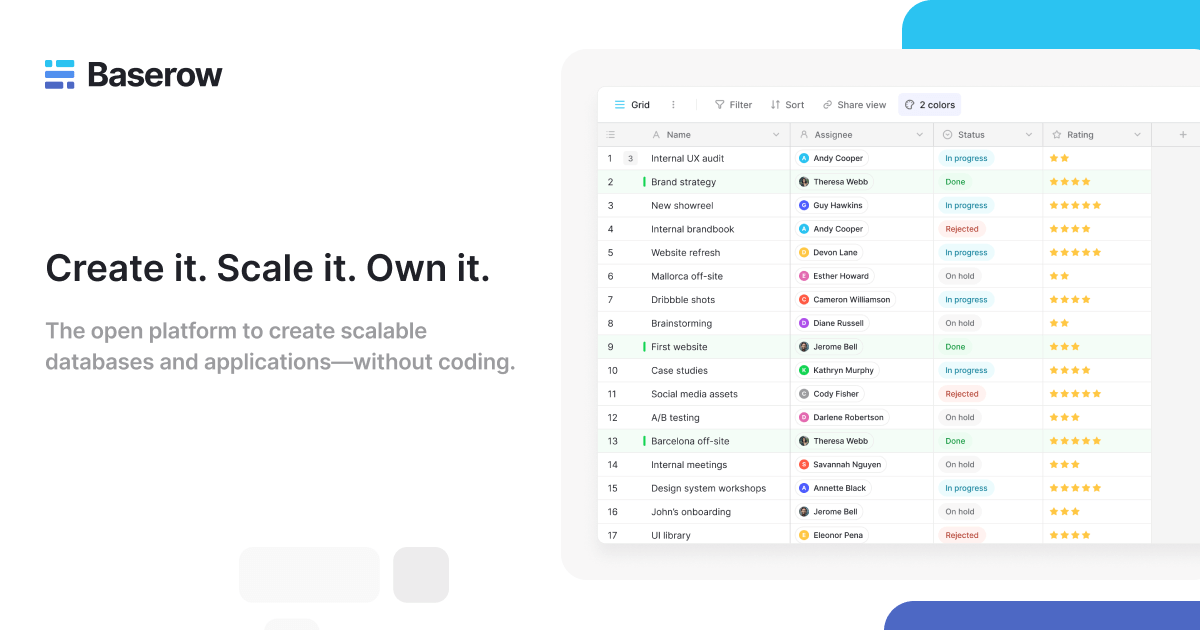Discover Exactly How Scalable Databases Can Be Used Without Coding to Enhance Your Organization Workflow
In today's fast-paced company setting, the capability to take care of and evaluate information effectively is critical. no-code. Scalable databases, especially when combined with no-code solutions, use a transformative approach that empowers non-technical users to streamline procedures.
Understanding Scalable Data Sources
Scalable data sources are vital for contemporary company operations, permitting organizations to efficiently manage enhancing volumes of information without sacrificing performance. These databases are created to adapt and grow to the transforming needs of a business, making certain that they can handle bigger datasets and more complex inquiries as organizational requirements progress.
Understanding scalable data sources includes acknowledging their 2 primary kinds: vertical scaling and horizontal scaling. Vertical scaling, or "scaling up," includes including even more power (CPU, RAM) to an existing server to boost performance. Conversely, straight scaling, or "scaling out," entails including much more servers to disperse the load, which frequently results in better flexibility and fault resistance.
One more critical aspect is the architecture of scalable databases, which can be either relational or non-relational. Relational databases, such as MySQL and PostgreSQL, are structured and make use of SQL for inquiries, while non-relational databases, like MongoDB and Cassandra, use even more flexibility with disorganized information.
Ultimately, understanding scalable data sources is important for services intending to take advantage of information as a critical possession, allowing them to remain competitive in a significantly data-driven setting.

Benefits of No-Code Solutions
Opening the capacity of no-code options encourages services to enhance operations and enhance productivity without the need for extensive programming expertise. These platforms permit non-technical users to develop, change, and take care of data sources effortlessly, thus democratizing accessibility to innovation throughout teams.
Among the primary benefits of no-code services is their speed of implementation. Organizations can rapidly release applications and automate procedures, substantially minimizing the moment invested on growth cycles. This dexterity makes it possible for companies to respond immediately to market changes and customer demands, cultivating an one-upmanship.
In addition, no-code systems lower dependence on IT divisions for daily jobs, allowing technological groups to concentrate on even more complicated tasks that call for specialized abilities. This shift not just optimizes resource appropriation but also advertises advancement within the company.
Cost-effectiveness is another benefit, as no-code solutions can lower advancement and maintenance expenses. By lessening the need for coding know-how, firms can harness the capabilities of their existing workforce without the overhead of employing added workers.
Popular No-Code Data Source Devices
The surge of no-code remedies has led to the emergence of various data source tools that deal with services looking for effectiveness and ease of access. These devices empower individuals with restricted technical proficiency to develop, handle, and manipulate data sources flawlessly.

Caspio sticks out for its capacity to build internet applications without any kind of coding. It permits companies to develop robust data sources and release applications promptly, satisfying different market needs. In a similar way, Knack provides user-friendly interfaces and effective data administration capacities, making it possible for organizations to construct find this personalized applications tailored to their workflows.

Use Cases in Business Operations
Just how can organizations utilize data source devices to boost their operations? Scalable data sources give organizations with effective abilities to manage and assess information without the need for comprehensive coding expertise. These devices can improve numerous service processes, eventually leading to enhanced effectiveness and performance.
One famous usage situation is consumer connection management (CRM) Businesses can use scalable data sources to track customer communications, preferences, and feedback, enabling tailored interaction and far better service. By centralizing this information, groups can team up better and react to client requirements in real-time.
An additional significant application is inventory monitoring. Business can utilize no-code database tools to keep an eye on stock levels, track deliveries, and forecast need. This makes certain optimum supply levels, decreases waste, and lessens stockouts.
Additionally, project monitoring can profit from scalable data sources by allowing teams to take care of jobs, deadlines, and sources in a linked platform. With real-time updates and information visualization, project supervisors can make enlightened choices.
Getting Going With Implementation
Executing scalable data sources in service procedures calls for an organized approach to make sure successful combination and utilization. The very first step is to carry out a comprehensive requirements assessment, recognizing details business needs, data types, and expected development patterns. This fundamental understanding will assist the choice of the ideal database remedy.
Following, select a straightforward, no-code database system that lines up with your functional objectives. no-code. Numerous modern-day options offer instinctive user interfaces, allowing non-technical individuals to handle data successfully. After selecting a system, develop a clear information design that outlines just how data will be organized, accessed, and maintained
Training is critical; make sure that staff member are outfitted with the required skills to use the data source. Consider supplying tutorials or workshops to familiarize team with the system's capabilities.
Final Thought
In investigate this site final thought, the assimilation of scalable data sources via no-code remedies presents considerable advantages for company operations. Ultimately, leveraging these technologies can lead to boosted productivity and functional efficiency, placing companies for sustained growth in a competitive landscape.
One preferred no-code database device is Airtable, which incorporates the functionality of a spread sheet with the power of a database.Exactly how can companies take advantage of data source tools to enhance their operations? Organizations can utilize scalable databases to track consumer communications, choices, and feedback, making it possible for tailored interaction and click over here now far better service.Implementing scalable databases in service procedures requires an organized strategy to ensure successful integration and use.In conclusion, the combination of scalable data sources via no-code solutions offers substantial benefits for business operations.